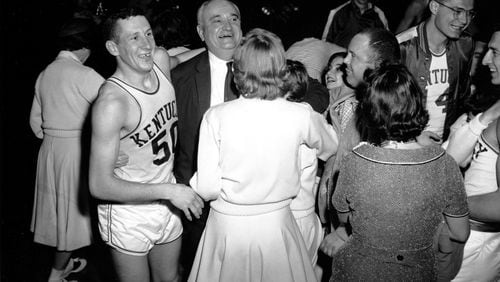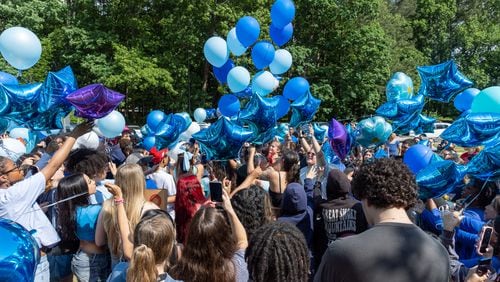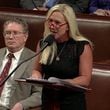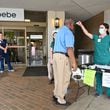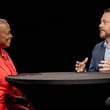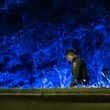Long before Michael Jordan wore powder blue, Dean Smith ran four corners and the University of North Carolina became a hotbed for basketball, Lennie Rosenbluth boarded a train in Grand Central Station with a suitcase in hand and no idea where his destination, Chapel Hill, N.C., even was.
His New York City buddies thought he meant he was going to N.C. State, a basketball powerhouse in the 1950s. That had been the plan, but a scholarship offer from legendary coach Everett Case proved only a tryout. Rosenbluth went with his backup plan to follow former St. John’s coach Frank McGuire to a school he knew nothing about.
“To say you got a scholarship offer now from Carolina, it’s like ‘Whoa,’” said Rosenbluth, 80, who lives in Chapel Hill and regularly attends games. “When I went, they said, ‘Where’s that?’”
In 1957, Rosenbluth led the Tar Heels to an undefeated 32-0 season and a national title in one of the greatest games in NCAA tournament history. When he returned to New York that March, it was to join his nemesis Wilt Chamberlain on “The Ed Sullivan Show.”
Rosenbluth captained the North Carolina team that went three overtimes to upset Chamberlain and Kansas at Municipal Auditorium in Kansas City, a night after going three overtimes to beat Michigan State.
“People said we played 10 times they would have beat us nine times,” said Rosenbluth, who saw Chamberlain over the years in Boca Raton, Fla., where Chamberlain had a restaurant and near where Rosenbluth taught history and coached high school basketball. “He never would say that. He just said we played very well against him.”
Carolina was ranked No. 1 because Kansas, then No. 2, had two losses. But it was obvious who the underdog was. Chamberlain was 7-foot-1. He had scored 52 points in his first college game. He would average 30 points and 20 rebounds in the NBA and go down as one of the game’s great players.
Rosenbluth said McGuire went down the Carolina bench before tipoff asking each player “Are you afraid of Chamberlain?” The answer, to a man, was no.
“We knew what we could do,” Rosenbluth said. “He said, ‘Kansas can’t beat you; Chamberlain can beat you.’”
This was before highlight shows and video scouting, but Rosenbluth and teammates Joe Quigg and Pete Brennan had gotten glimpses of Chamberlain while playing summers exhibitions in the New York Catskills.
“We knew how big he was,” Rosenbluth said.
As if to make the point that Chamberlain’s size wouldn’t bother the Tar Heels, McGuire sent 5-foot-11 Tommy Kearns to the center circle for the opening tip and the other four players back to wait in a zone.
“You don’t want them to tip the ball, pass to Chamberlain and he comes down and ‘boom’ and the crowd goes berserk,” Rosenbluth said. “And it worked…
“Tommy crouches down like he’s going to get the jump and the picture is Wilt looking down on him like ‘What in the world is going on?’ They got the tip, but they couldn’t get the ball into Chamberlain. The first four or five minutes they couldn’t even get the ball inside to him.”
The Tar Heels triple-teamed Chamberlain, daring any other Jayhawk to beat them. They couldn’t. Kansas shot only 27 percent, while the Tar Heels shot 64 percent.
Rosenbluth scored 20 points before fouling out with 1:45 left in regulation. Chamberlain played all 40 minutes of regulation and 15 minutes of overtime, finishing with 23 points.
“He told McGuire when McGuire coached him at Philadelphia, he thought we were a bunch of Indians running around him,” Rosenbluth said. “He felt like Custer, couldn’t move.”
Ironically, it was while playing for McGuire that Chamberlain became the first player to score 100 points in an NBA game. But on that Saturday night in 1957 in front of 10,000 mostly Jayhawks fans, Chamberlain was held to two points in the first two overtimes as both teams stalled.
The Jayhawks were up by one with 10 seconds to play in the third overtime when Quigg drove the lane and got blocked by Chamberlain, but he was fouled by Maurice King. McGuire called timeout, something he never did in the final two minutes of a game, Rosenbluth said.
“Most times, the other coach calls timeout to ice him,” Rosenbluth said. “McGuire calls timeout and he tells Joe, ‘This is what we’re going to do after you make your foul shots.’ And Joe told coach, ‘I’m going to make them both; don’t worry about it.’”
He did. And he intercepted a pass intended for Chamberlain on the ensuing play. Quigg then passed to Kearns, the 5-11 jump ball specialist, who threw the ball high in the air as time expired. North Carolina 54, Kansas 53.
“The silence after the game…,” Rosenbluth said. “Kansas people were just completely stunned.”
While Rosenbluth flew with McGuire and Chamberlain to New York, his teammates landed in Raleigh-Durham, where so many fans gathered on the tarmac, the pilot had to circle before security could clear a safe place to land. The landscape there had changed forever.
When Rosenbluth first got to North Carolina, he remembers playing a freshman game against Navy where they had to find a custodian to unlock the 4,500-seat Woollen Gym.
Longtime North Carolina broadcaster Woody Durham told Rosenbluth that by 1957, the Tar Heels managed to clear his high school gym in Albemarle, N.C., one night. Somebody had said the undefeated Tar Heels were about to lose to Maryland. Fans rushed to their cars to listen on the radio as North Carolina came back from four points down with two minutes left.
Both Final Four games in Kansas City were broadcast live on five TV stations in North Carolina for the first time, thanks to entrepreneur C.D. Chesley. The following season he started an ACC network.
The night of the championship game, Tar Heels players walked back to the hotel in their uniforms to shower. There, they were introduced to a Kansas graduate, then an assistant at Air Force, who would join McGuire’s staff the following season: Dean Smith.
Rosenbluth said he didn’t realize the magnitude of what that team accomplished until 50 years later. In 2007, Smith brought back the 1957 team to be honored at halftime of a game along with the 1982 national championship team, celebrating its 25th anniversary.
After the cheers subsided and the ceremony broke up, Jordan, Sam Perkins and James Worthy came over to shake hands with players from the ’57 team.
“They said ‘You were the guys that started it all,’” Rosenbluth said. “’That’s why we’re here.’”
About the Author
